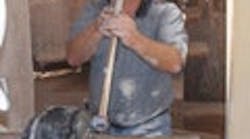At its Lovelock, Nev., plant, EaglePicher mines and processes diatomaceous earth, a naturally occurring, soft, chalk-like sedimentary rock used as a filtration aid, a mechanical insecticide and a component of dynamite, as well as other applications. Its composition typically is 86% silica, making it mildly abrasive, and its microscopic particle size makes if difficult to exclude from bearings on the large blowers used in processing the material.
Blower bearings were failing prematurely because of installation difficulties and the abrasiveness of the material. The installation of split-housing bearings requires premeasuring the clearance, then tightening the tapered adapter nut in increments, using feeler gauges to determine when a specified clearance is reached. If this procedure is performed incorrectly, the bearing might not grip the shaft, or the clearance might be too tight.
Second, it’s necessary to assemble the bearings and set the clearances on-site, and at EaglePicher, the pervasive fine dust in the air made it almost impossible to keep particles out of the bearing during this procedure.
Consistent installation is eased by optical strain sensing (OSS) technology, which gives a visual indication when proper mounting torque is reached.
When the bearings on one large blower failed, EaglePicher replaced them with Rexnord ZAF6000 Series Adapter Mount Roller SHŪRLOK bearings with optional auxiliary end caps. The ZAF6000 bearings are solid-housed, shaft-ready units that are a drop-in to traditional SAF units. They are greased and the clearance is preset, so they can be taken out of the box and mounted to the shaft immediately. A positive locking system maintains mounting tightness during operation, and a tapered adapter sleeve provides greater shaft grip and eliminates the shaft damage caused by loose bearings. (The tapered sleeve also eases removal of the bearings without shaft damage.)
The new bearings incorporate Spyglass optical strain sensor (OSS) technology, which provides instant feedback during installation to achieve optimal shaft grip and avoid shaft and bearing damage caused by improper tightening.
The blower was about 8 feet in diameter, rotating at 900 rpm and mounted on a 2 15/16-in. shaft supported by two bearings. The blower’s weight and configuration produced an overhung load, which made it more difficult to determine when zero clearance was reached between the inner race, sleeve and shaft during installation.
“When we removed the caps from one of the SAF split-block bearings, it was completely loose on the shaft,” says Mark Czubak, manager of product engineering, Rexnord Bearing (www.rexnord.com), who was involved in the installation. “That made it necessary to replace the shaft because the loose bearing caused it to wear excessively.”
Once the shaft was replaced, installing the new bearings took less than an hour, including training the EaglePicher maintenance technicians in the process. “The bearings are completely assembled and lubricated, so we just slid them onto the shaft and tightened them in place,” Czubak says. “Our service instructions call for tightening until there is no clearance between the adapter sleeve and the inner ring, and then tighten one more turn. The overhung load of the large blower made it difficult to determine that point. Once we got it as close as we could, we tightened the locknut a bit more, and the Spyglass OSS window on the bearing indicated we were at the correct torque.”
The patent-pending OSS technology is a full-field stress analysis and incorporates materials that respond to strain by changing reflected light wavelengths. Marlon Casey, the Rexnord engineer who developed this technology, explains, “As the ambient light is reflected through the element, it appears clear. The element isolates the wavelengths, depending on the direction of strain and the angle by which the light passes through the strained member. We calibrated it so that the window stays clear until there is enough strain on the locknut to provide a sufficient load. At that point, the light seen in the window changes, showing that the minimum threshold of load has been reached.”
